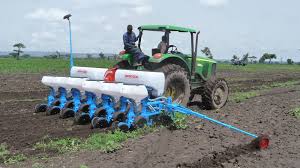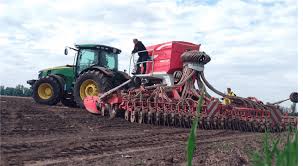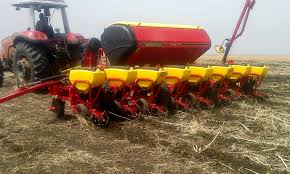Grain drills and planters, regardless of type, operate on the same basic principles. Seed is stored in a hopper, and a mechanism driven by ground wheels or disks releases seed at a metered rate.
Seed falls to the soil surface, where a compaction device seals it into the ground. Seed boxes exist in three configurations: standard, legume, and native grass (fluffy) seed.
Each box handles specific seed types and can be calibrated independently, aiding in planting seed mixes at desired rates. Standard seed boxes manage large, smooth seeds like corn, soybeans, peas, wheat, and oats, relying on gravity and seed smoothness, often with agitation.
These boxes cannot handle light, fluffy seeds, which may bridge and clog the planter or be difficult to calibrate for small seeds like clovers. Small-seeded species require a smaller delivery mechanism for accurate planting rates.
Seed travels through drop tubes to disc-shaped “V” openers, falling into a soil slice before being covered and sealed by a compaction device.
The legume box, smaller than the standard box, handles tiny seeds, using gravity to feed the mechanism, delivering seed to the ground just before a compaction device like press wheels or a cultipacker.
Seed from this box plants shallower than from the standard box, and large seeds can jam its smaller delivery mechanism.
The native or fluffy seed box, similar to the standard box, includes aggressive agitation to prevent bridging, often using a “pick” wheel to pull seed into larger-diameter drop tubes to avoid clogging.
Read Also: Goats Farming Complete Practical Guide
Row-Crop Planters for Precision Planting

A row-crop planter allows variable spacing between plants on the same row or ridge and between rows, enhancing planting precision in agriculture.
Components of Row-Crop Planters
The major components include:
1. Seed Hopper for Storage: Holds seeds, made of sheet metal, plastic, or both. Metal hoppers may have a seed-level indicator, while translucent plastic hoppers show seed levels.
Hopper shapes (trapezoidal, rectangular, or oval) and capacities vary, with trapezoidal designs ensuring free seed flow. Each row has a hopper, sometimes including a separate fertilizer hopper.
2. Seed Metering Mechanism for Spacing Control: The most critical component, located at the hopper’s base, controls seed spacing within and between rows.
Types include horizontal plate, inclined, vertical rotor, belt-type precision, finger pick-up, pneumatic, and fluted feed roller, though fluted rollers are less common due to inaccurate seed release at varying speeds.
Seed plates with peripheral cells receive seeds, with cell number and shape based on desired spacing and seed type (e.g., edge-drop, flat-drop, full-drop plates).
3. Seed Tube for Delivery: Carries seeds from the metering mechanism to the furrow opener, using collapsible (telescopic or spring coil) or rigid tubes made of plastic or metal.
4. Furrow Openers for Soil Preparation: Also called runners, these create furrows. Some tractor-drawn maize planters use a lister plough bottom and two shovels to open and cover furrows, prioritizing moisture conservation in dry areas.
5. Covering Device for Seed Protection: Covers seeds in the furrow. Soil may naturally fall back, but if it remains uncovered due to soil moisture or type, a covering device like a chain or press wheel ensures soil coverage and gentle compaction.
6. Fertilizer Attachments for Nutrient Application: Apply “starter” fertilizer 5 cm below and beside the seed row, or herbicides/insecticides in liquid or granular form at low rates. Granular applicators, mounted per row, are driven by press wheels or the planter’s main drive.
7. Tillage Attachments for No-Till Planting: No-till planters require additional weight and down-pressure springs. Fluted coulters (7.5 cm wide, 10–13 cm deep) and ripple coulters (2–4 cm wide) prepare seedbeds without prior tillage.
8. Seed Monitors for Planting Accuracy: Modern planters use electric-eye seed monitors to track seed drops and indicate planting population per row.
Read Also: Introduction to Ruminant Animals Production
Grain Drills for Uniform Seeding

A grain drill varies row spacing and places seeds in a continuous flow at a uniform rate and controlled depth, with or without soil covering. Some include fertilizer attachments, termed seed-cum-fertilizer drills, with a divided seed box for seeds and fertilizers.
Drills are classified as bullock-drawn or tractor-drawn, with bullock-drawn drills further divided into hand-dropped or mechanically metered types, such as the three-tined cultivator with seeding attachment, varying by region.
Components of Grain Drills
Key components include:
1. Frame for Structural Support: Made of angle iron with braces and brackets, designed to withstand operational loads.
2. Seed Box for Storage: Constructed from mild steel or galvanized iron with a cover, sometimes with an agitator to prevent clogging.
3. Seed Metering Mechanism for Delivery: Delivers seeds or fertilizers at selected rates.
4. Furrow Openers for Seed Placement: Create furrows for seed deposition.
5. Covering Device for Soil Coverage: Refills furrows using chains, drags, packers, rollers, or press wheels.
6. Transport Wheels for Mobility: Fitted on the main axle, sometimes pneumatic, with attachments to power the seed-dropping mechanism.
Common Problems to Avoid in Planter and Drill Maintenance
Planters and drills require routine maintenance, including lubrication and cleaning, and should be stored out of weather. Empty seed boxes after planting to prevent mold, germination, or pest damage causing oxidation, corrosion, or clogs.
Inspect drop tubes for blockages from spider webs, insects, or mice using an air compressor. Ensure all tubes drop seeds during calibration and monitor seed levels during operation.
Avoid backing up with “V” openers lowered to prevent jamming with rocks or soil. Regularly check drive mechanisms, especially disk- or coulter-driven planters, for debris.
Verify planting depth by digging and adjust as needed, particularly for no-till drills. Ensure press wheels seal “V” opener furrows without excessive packing.
Avoid planting in soft, unpacked seedbeds with drill-type planters to prevent overly deep seed burial after rain. Use debearded native or fluffy seeds with dry lubricants like powdered graphite to reduce bridging, and check drop tubes frequently.
Use appropriate seed boxes to avoid uneven seed distribution from mixing small and large seeds.
Do you have any questions, suggestions, or contributions? If so, please feel free to use the comment box below to share your thoughts. We also encourage you to kindly share this information with others who might benefit from it. Since we can’t reach everyone at once, we truly appreciate your help in spreading the word. Thank you so much for your support and for sharing!

